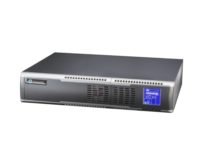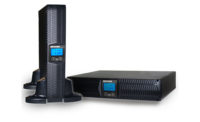
Rising Power Needs, New Regulations
Ironically the move toward more eco-friendly power supplies comes at a time when manufacturers have seen the power needs for security systems rising. “Demands on intrusion systems have gone up as building size has increased,” comments Gene Pecora, general manager of Northford, Conn.-based manufacturer Honeywell Power Products. While a 1A power supply might have been typical for a residential alarm system in the past, today it’s not uncommon for a system to require a 3 or 5A power supply, Pecora says.
Meanwhile today’s fire systems must meet standards requiring the systems to notify people of certain conditions — a requirement that wasn’t so common in the past. That trend has increased the power requirements for fire systems from 6 or 8A to as high as 12A, notes Pecora.
Fire systems traditionally have had external power supplies, but as power requirements have grown, security dealers increasingly have come to use external power supplies for intrusion systems as well, rather than the power supplies that traditionally are built into the alarm panel. That reality has driven demand for supervised power supplies that report back to the panel if the power supply is tampered with or if AC power is interrupted, notes Jonathan Jennings, sales trainer for Elk Products, a Hildebran, N.C.-based manufacturer that recently introduced supervised alarm system power supplies.
As power requirements for alarm systems and other electronic devices have grown, however, policy makers have become increasingly concerned about their power consumption. California tends to be a bellwether state when it comes to environmental regulations and a law recently passed in the state aims to minimize the power consumed by low-voltage devices.
As Pecora explains, the primary focus of the new legislation was on cell phones and electronic games, but because fire and intrusion systems also use low-voltage equipment, the law ultimately will impact them as well. The state of California did, however, give the alarm industry a few extra years to comply with the new regulations. By then, some other states also may follow California’s lead in enacting similar legislation.
“The typical power supply is designed to convert a line [input] to low-voltage,” explains Pecora. In the process, he says, power supplies produce heat. The California law requires power supplies to operate more efficiently and to produce less heat, Pecora says. It also requires the power supplies to be able to detect and to automatically shut down when no load is present.
Honeywell and other manufacturers are in the process of redesigning their power supplies to use a new architecture that will enable them to meet the California requirements. As they make this move, power supplies are likely to become lighter, notes Pecora. “Old chargers were heavy,” he says. But if a person picks up a device that conforms to the new requirements, he says, “It feels almost like the can is empty.”
Other advances in power supplies are driven by regulations that have been adopted in Europe that could make their way to the United States, including a requirement to use power factor correction on the input, notes Jerry Baker, vice president of engineering for Tracy, Calif.-based manufacturer Electronic Security Devices. “Without power factor correction, a power supply has high-current spikes,” explains Baker. “Correction makes it so the current and voltage are always together so there is no spiking.” This, in turn, reduces the load on the local power company, Baker says.
Simplified service
Other advances in power supplies make them easier to service.
ESD offers power supplies with built-in diagnostics. The technology, dubbed Smart Power, provides technicians with information about the power supply’s current average temperature and other critical measurements. “If a power supply is rated at 1 or 2A, an LED will blink to tell you if you’re beyond the rating,” notes Baker.
Honeywell provides similar functionality in power supplies that retain memory of past events to help in troubleshooting. “Some difficulties are intermittent,” notes Pecora. “It’s good to have a history of what’s happened in the past.”
For fire installations, Honeywell also offers a power supply that supports variable end-of-line resistors. In the past, if a system was being retrofit, technicians might have to locate and replace the end-of-line resistor. The new feature eliminates that requirement by changing the value the panel is looking for.
Demand for Longer Backup Time Drives UPS Innovation
Unlike low-voltage fire and intrusion systems, some other types of security equipment — including the computing equipment in the central station, as well as some video and home automation devices — rely directly on AC power. To protect such equipment from power surges and brownouts, it’s important for an uninterruptible power supply (UPS) system to be included in the installation.
An important trend in UPS systems is greater use of external battery packs.
A typical UPS system has a built-in battery that also provides backup power, but often the backup power only lasts for 15 minutes or so, notes Bill Allen, director of marketing for Carrollton, Texas-based Para Systems, which manufactures UPS systems under the Minuteman brand.
“We’re seeing a focus on longer battery backup times,” Allen says.
Security dealers can address this need by using larger UPS systems but Allen says, “A more elegant solution would be to provide a UPS with external battery pack capability.”
Central stations’ unique power requirements
Nowhere is backup power more important than for the central station responsible for monitoring thousands of accounts. For optimum backup protection, central stations may opt to use a UPS that is backed up by a generator.
When selecting a UPS, central station decision-makers should make sure to purchase a line-interactive system, advises Allen.
A line interactive UPS constantly monitors voltage at the input, boosting or reducing it to keep it at a steady output. Systems that are not line interactive solve power problems by going to the battery, which can shorten battery life, Allen says. Another option is to use an online UPS that uses a DC conversion process to regulate the system, which Allen says is “the safest and most secure but more expensive.”
The UPS, which is so critical to central station power backup, creates some specific requirements for any generator installed to back it up. UPS systems put particular demands on generator sets because they are non-linear in nature, according to Gary Olson, director of technical support with Minneapolis-based manufacturer Cummins Power Generation. “Non-linear loads distort the voltage waveform of a generator, and require use of good voltage regulation equipment for proper operation. This is particularly true for generators rated less than 200 kW, which often are supplied as standard with less expensive and capable voltage regulators. For non-linear loads, you need a voltage regulator that is three-phase sensing (assuming you have three-phase power), full wave rectification, pulse width modulation, and an independent power supply, such as a permanent magnet generator.”
Olson also advises that the National Electrical Code recently was modified to include requirements for facilities that are deemed by authorities as “critical infrastructure.” When this occurs, data centers and other facilities must meet installation and performance requirements that are the same as more traditional critical facilities like hospitals. There are many specific requirements that can add significant cost to a facility, but result in a considerably more reliable power supply for the facility. So, it’s critical that an owner be aware of the requirements prior to construction planning.
One piece of good news is that new generator sets are available with excellent sound attenuation equipment and will include engines that exhaust less than 10 percent of the harmful contaminants that they have in the past. Some areas of the country that suffer from poor air quality will have even stricter requirements starting in 2011. Most manufacturers can meet these requirements, but at significant added cost. “You won’t see the black smoke from the diesel engine that you have seen in the past,” comments Olson. “It’s getting to the point that you can almost breathe the exhaust. You won’t see it and probably won’t even smell it.”
Security Dealers Enter Stand-by Generator Business
Smart security dealers are always on the lookout for new products that can help boost system revenues. One product that dealers should consider adding to their residential product portfolio is the backup generator.
“We look at having a stand-by generator as a new insurance policy on top of the security system to make sure systems will be powered 24/7,” comments Cathy Olig, senior channel manager for Waukesha, Wisc.-based manufacturer Generac Power Systems.
It’s a natural fit for security dealers to sell stand-by generators as part of the security and life safety sale. Making the sale, Olig says, often may be a matter of simply continuing the conversation with the customer about what happens when the power goes out.
Generac has seen increased interest in stand-by generators as sales of home automation systems have risen, notes Jake Thomas, product manager for the company. Unlike burglar and fire alarm systems, home automation systems may not have extended battery backup time.
People with critical medical equipment also are excellent prospects for standby generators, as are people who work from home and can’t afford to be without power, notes Chad Boutet, residential marketing manager for Minneapolis-based manufacturer Cummins Power Corporation.
Getting into the stand-by generator business requires specialized training. Generac and Cummins offer online and in-person training so resellers can learn how to select the best generator based on specific customer needs.
The choice will depend on “a combination of how much customers want to run and what they want to spend,” comments Thomas. Customers may be able to reduce the size and cost of their systems by opting to use load distributing to periodically turn off air-conditioning or other equipment that consumes a high amount of energy, Thomas says.
Security dealers who are interested in adding home stand-by generators to their business portfolio also may need to create some new partnerships. Installing stand-by generators requires plumbers to install the connection for natural gas or propane and an electrician to handle the wiring, notes Boutet.
“The most successful dealers are those who have brought together a group of experts in their fields,” comments Boutet. These include the plumber, the electrician and the security dealer. Any one of them may be able to generate a sale that all three can participate in.
Of the three partners, it’s the security dealer who may be best suited to handle the important requirement of setting up the homeowner’s computer to interface with the home standby generator. Through that interface, Cummins products have the ability to automatically notify homeowners by email if the generator fires up — and homeowners can check on system status at any time from a Web browser.
Power Supply Tips
Allen Forman, president of Brooklyn, N.Y.-based power supply manufacturer Altronix Corporation offers these tips for installing and servicing power supplies:
1. Assure that power supplies are easily accessible with ample room for stand-by batteries and cable management.
2. Determine the physical location and proximity to the security equipment and the appropriate wire gauge required.
3. Make sure there is appropriate ventilation when installing rack mount power supplies and that any outdoor power supplies will operate in the prevailing temperature ranges and conditions.
4. Make sure power supplies are installed in compliance with specific building code requirements under the auspices of the authority having jurisdiction.


